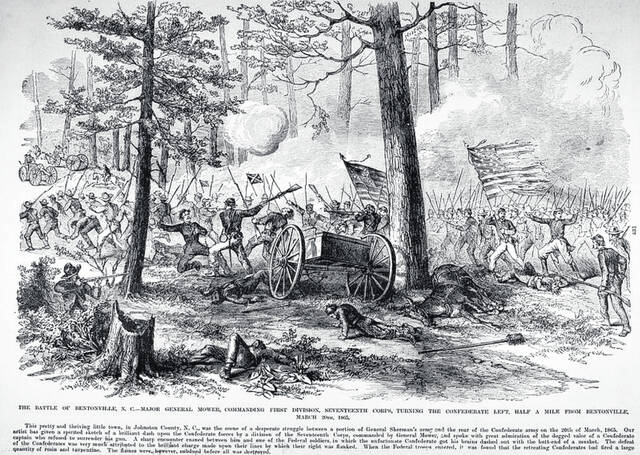
This depiction portrays a Confederate army led by Gen. Joseph Johnston attacking the left wing of Union Gen. William Sherman’s army.
North Carolina Department of Natural and Cultural
THIS WEEK IN HISTORY
NORTH CAROLINA HISTORY
MARCH 16: Last Whale Killed Off the North Carolina Coast. A whale skeleton during assembly at the N.C. Museum of Natural Sciences circa 1900-1920. On March 16, 1916, the last whale killed by North Carolina fisherman was caught near Cape Lookout.
Whaling was practiced in North Carolina since the colonial era, and the first evidence for whaling in North Carolina comes from a 1666 commercial whaling license issued by Peter Carteret, the assistant governor of the North Carolina colony. The industry quickly became prosperous with English and Scottish settlers setting up fisheries up and down the coast to catch and process whales for their meat, oil and bone. North Carolinians played an active role in this industry although their participation was most often shore-based as opposed to oceanic.
By the early 20th century, as Americans turned to gasoline and kerosene for their heating and lighting needs, and to synthetic substances for greasing, whale oil fell into disuse and the shore-based whaling industry collapsed.
MARCH 17: Mia Hamm a UNC soccer star. A native of Alabama, Mia Hamm, born March 17, 1972, made her mark in North Carolina during her years with the UNC women’s soccer team (1989-94). She helped them to win four of their record twenty NCAA championships. During her 17 year career, she scored 158 international goals (the most of any player, male or female), played in 275 international games, and was instrumental in the 1991 and 1999 World Cup wins for the US National Team, as well as helping to win two gold medals in the 1996 and 2004 Olympics.
Since her retirement in 2004, Hamm has been active in the Mia Hamm Foundation. She was inducted into the National Soccer Hall of Fame in 2007.
MARCH 18: Marines Begin Flight Operations at Cherry Point, 1942. On March 18, 1942, flight operations began at the Marine Corps Air Station Cherry Point in Craven County with the landing of a Grumman J2F “Duck” amphibian.
The base was established just a few years earlier, after the Marine Corps conducted a search up and down the U.S. East Coast for a suitable site for an air station. After Congressman Graham Barden helped secure $40 million for construction in 1941, the base grew quickly, becoming a self-contained city of 20,000 within a few months.
As the U.S. involvement in World War II ratcheted up, so did the size and scope of Cherry Point. It was the home of the 3rd and 9th Marine Aircraft Wings during the war and has been the home of the 2nd Marine Aircraft Wing since 1946.
Troops from Cherry Point have taken part in every major military engagement since 1941 and the base is the largest Marine airfield in the world today.
MARCH 19: Last Stand in the Carolinas at Bentonville. On March 19, 1865, at Bentonville, a Confederate army led by Gen. Joseph Johnston attacked the left wing of Union Gen. William Sherman’s army. General Robert E. Lee directed the Confederates to make a stand in North Carolina to prevent Sherman from joining General Ulysses S. Grant in front of Lee’s army at Petersburg, Virginia.
Union Gen. Henry Slocum, initially not realizing that he faced an entire army, pushed forward, but was driven back throughout the afternoon. Confederates led by Gen. D. H. Hill were able to flank Slocum’s troops, pouring devastating fire on them. Johnston continued his assaults throughout the evening but pulled back after realizing that the right wing of Sherman’s army, which was marching from Fayetteville toward Goldsboro, would arrive soon.
Sherman’s army of 60,000 men was divided into two wings: half were in the left wing marching through Averasboro and Bentonville and half were in the right wing marching on a parallel route to the southeast. Sherman’s objective was Goldsboro, where 40,000 additional troops and supplies would reinforce his army.
After initial success on March 19, the Confederates were unable to subdue the Union army, and early on March 22 they withdrew. The Union Army did not pursue them. The action was the largest during the Civil War in North Carolina.
MARCH 20: Turkey’s Talons Tied to Jurist’s Demise. On March 20, 1793, Samuel Spencer died. Spencer was a member of North Carolina’s colonial assembly, the state’s de facto executive during the Revolutionary War, a trustee of the University of North Carolina, a colonel in the militia and a superior court judge. He voted against the new federal constitution because it did not yet have a Bill of Rights.
The judge also played a major role in the landmark legal case of Bayard v. Singleton, the first instance in which a court declared an act of the post-revolutionary North Carolina General Assembly unconstitutional.
Spencer had a most unusual death, by turkey. At age 60, Spencer was napping outside on his porch, wearing a red cap. Spencer’s bobbing head was then taken for a challenge by a turkey, which attacked the judge with such violence he was thrown from his chair.
The judge died a few days later from either from injuries sustained in the fall, or from an infection from the scratches.
March 21: Freedom Riders Surrender in Hillsborough. On March 21, 1949, the Freedom Riders surrendered at the Orange County Courthouse in Hillsborough and were sent to segregated chain gangs.
In 1946 the U.S. Supreme Court declared that segregation on interstate buses and trains was unconstitutional, though segregation was still widely practiced across the south. The Congress of Racial Equality (CORE) decided to test compliance with the court’s ruling across the South by having interracial groups of protesters travel on Greyhound and Trailways buses. This “Journey of Reconciliation,” as it was dubbed, began in April 1947, and the protesters who participated became known as the “Freedom Riders.”
In Chapel Hill in April 1947, four riders, including one of the organizers, Bayard Rustin, were arrested and later went to trial. In 1949, Rustin and two white protesters surrendered and were sent to segregated chain gangs. Rustin published journal entries about the experience. His writings, as well as the actions of the “Journey” riders in April 1947, in time inspired Rosa Parks’ nonviolent protest in 1955 and the Freedom Rides of 1960-1961.
March 22: Governor O. Max Gardner and the Great Depression. On March 22, 1882, Governor Oliver Max Gardner, whose political organization known as the “Shelby Dynasty” dominated state politics for a generation, was born in Cleveland County.
Gardner took office as governor only months before the stock market crash of 1929, and the Great Depression that followed presented Gov. Gardner with many unforeseen challenges. One of his many initiatives was to promote his “Live-at-Home” program to encourage the planting of crops for subsistence.
O. Max Gardner when he was a football player at UNC-Chapel Hill. To help alleviate budget crises in counties across the state, Gardner authorized a study of state government which recommended a massive shift of power to Raleigh, with the state taking responsibility for roads and schools. He counted the consolidation of universities in Chapel Hill, Raleigh and Greensboro as his proudest achievement and, in this as in other efforts, his moves were opposed by special interests and required all the his leadership abilities to come to fruition.
The next four governors, including his brother-in-law Clyde R. Hoey, came to office with his backing. In 1947, Gardner was named Ambassador to Great Britain but died hours before he was to sail for London.
STATE AND WORLD HISTORY
MARCH 16, US soldiers kill hundreds of unarmed Vietnamese in My Lai massacre. On March 16, 1968, the My Lai (mee ly) massacre took place during the Vietnam War as U.S. Army soldiers hunting for Viet Cong fighters and sympathizers killed unarmed villagers in two hamlets of Son My (suhn mee) village; estimates of the death toll vary from 347 to 504.
MARCH 17, Michael Jordan becomes minority owner. In 2010, Michael Jordan became the first ex-player to become a majority owner in the NBA as the league’s Board of Governors unanimously approved Jordan’s $275 million bid to buy the Charlotte Bobcats from Bob Johnson.
March 18, Hitler and Mussolini join forces. On March 18, 1940, Adolf Hitler and Benito Mussolini met at the Brenner Pass, where the Italian dictator agreed to join Germany’s war against France and Britain.
March 19, Dive bombers kill hundreds. On March 19, 1945, during World War II, 724 people were killed when a Japanese dive bomber attacked the carrier USS Franklin off Japan (the ship was saved). Adolf Hitler ordered the destruction of German facilities that could fall into Allied hands in his so-called “Nero Decree,” which was largely disregarded.
March 20, Menendez brothers convicted. On March 20, 1996, a jury in Los Angeles convicted Erik and Lyle Menendez of first-degree murder in the shotgun slayings of their wealthy parents. (They were sentenced to life in prison without the possibility of parole.)
March 21: Al Gore fights against global warming. In 2007, former Vice President Al Gore made an emotional return to Congress as he pleaded with House and Senate committees to fight global warming; skeptical Republicans questioned the science behind his climate-change documentary, “An Inconvenient Truth.”
Executive Editor David Kennard compiles the History column from Robesonian archives, the North Carolina Department of Natural and Cultural Resources and Associated Press reports.









